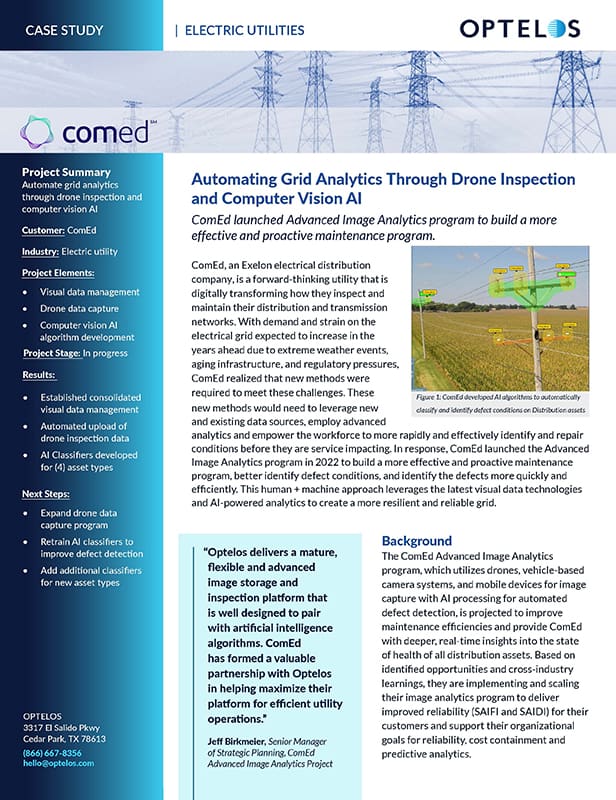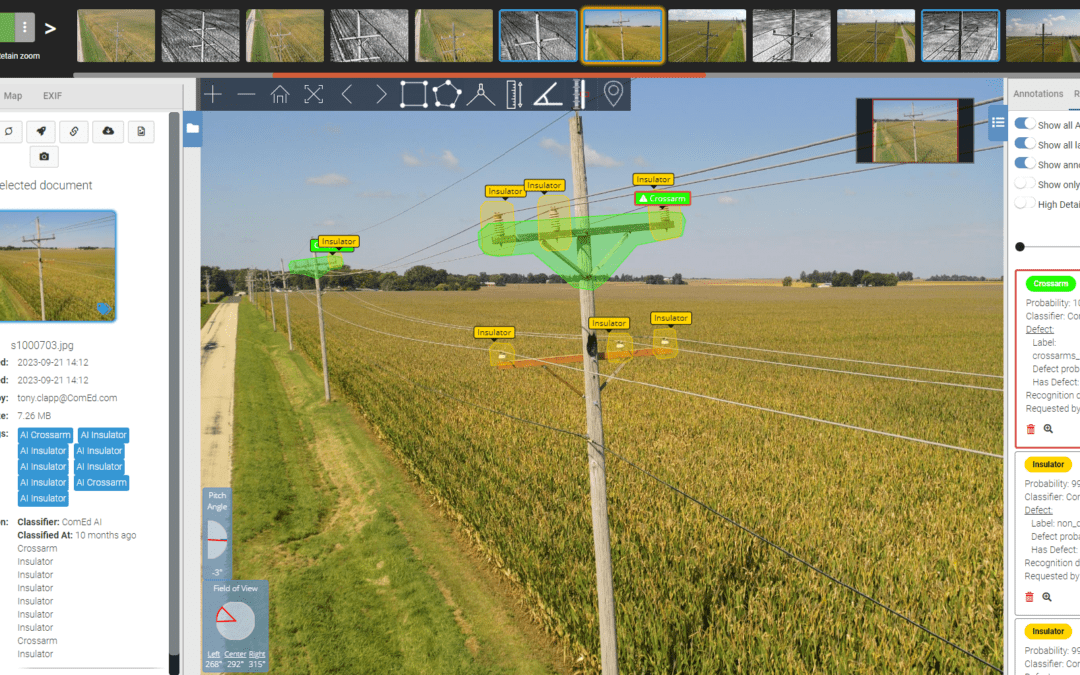Download the case study below, which outlines how ComEd is automating their grid analytics through drone inspection and computer vision AI analysis of the captured imagery. ComEd launched their Advanced Image Analytics program in 2022 in order to build a more effective and proactive maintenance program.
ComEd, an Exelon electrical distribution company, is a forward-thinking utility that is digitally transforming how they inspect and maintain their distribution and transmission networks. With demand and strain on the electrical grid expected to increase in the years ahead due to extreme weather events, aging infrastructure, and regulatory pressures, ComEd realized that new methods were required to meet these challenges.
These new methods would need to leverage new classify and identify defect conditions on Distribution assets and existing data sources, employ advanced analytics, and empower the workforce to more rapidly and effectively identify and repair conditions before they are service impacting. In response, ComEd launched the Advanced Image Analytics program in 2022 to build a more effective and proactive maintenance program, better identify defect conditions, and identify the defects more quickly and efficiently. This human + machine approach leverages the latest visual data technologies and AI-powered analytics to create a more resilient and reliable grid.
Background
The ComEd Advanced Image Analytics program, which utilizes drones, vehicle-based camera systems, and mobile devices for image capture with AI processing for automated defect detection, is projected to improve maintenance efficiencies and provide ComEd with deeper, real-time insights into the state of health of all distribution assets. Based on identified opportunities and cross-industry learnings, they are implementing and scaling their image analytics program to deliver improved reliability (SAIFI and SAIDI) for their customers and support their organizational goals for reliability, cost containment, and predictive analytics.
ComEd started the program in 2022 by first engaging Deloitte through an RFP process to provide data science expertise, image labeling resources, and project management support. Deloitte worked with internal ComEd data scientists and Optelos to help drive the project forward and focused on the following areas:
- Standardized visual data collection program: Using Drones, vehicle-based cameras, mobile devices, and LiDAR to collect geolocated images of all grid assets and vegetation encroachment.
- Visual data management: Implement the Optelos Enterprise Asset Advisor platform as the centralized visual data management and AI image analytics solution, where all geolocated images and relevant asset data would be located.
- AI development and deployment: Implement an AI development and deployment workflow to continue to optimize program performance with additional AI classifiers and algorithm improvements. This includes a model retraining pipeline to iterate on model development and improve performance over time.
- Professional program management: Utilize a change management program using Deloitte professional services to ensure on-schedule implementation and program adoption across all impacted work groups.
- Drone Data Capture: ComEd utilizes quadcopter drones for distribution infrastructure inspection, and fixed-wing drones.
- Image Analytics & Management: Optelos Enterprise Asset Advisor was selected as the visual data management solution through an RFP process. Optelos is the central technology stack for drone and PTZ image storage, summary dashboards, data annotations for AI labeling, and AI training and data access via service territory maps.
- AI Algorithm development: ComEd developed the AI algorithms with Deloitte to classify and detect the fault conditions for defects on pole tops, cross arms, insulators, and lightning arrestors.
Implementing a Data Management Foundation for the Program
The team began by populating the Optelos visual data management platform with existing legacy asset data and new drone inspection imagery. A custom Optelos GUI mapped the assets by GPS location and correlated their respective imagery and asset detail to ComEd’s established serving territories, making the new system intuitive for the maintenance team members by closely aligning it with their existing workflow. The technical implementation includes automatically ingesting new and existing inspection imagery into the Optelos platform and accurately correlating those images with the right asset using the Optelos GPS auto-upload feature, which automatically determines which asset the image should be assigned by extracting image metadata (GPS location and camera azimuth), creating an intuitive, accurate, and accessible asset database.
Creating a Rapid AI Development and Deployment Environment
In addition to the visual data management requirement, ComEd implemented a Computer Vision AI workflow that would allow rapid development and deployment of AI classifiers to detect a broad range of assets and asset defect conditions.
The AI capability within the Optelos platform allows data scientists to manage the entire AI workflow from data labeling, creation of labeled data sets, and AI training to deployment and testing of AI classifiers.
ComEd and Deloitte together developed four separate classifiers to identify and detect common defects on distribution assets such as cross arms, insulators, cutouts, and lightning arrestors. These AI models have been tested against manually inspected lines to determine that their current detection accuracy rate varies from 58% to 90%. The target accuracy rate is 85%+, which will be achieved with ongoing AI training managed via creating and submitting new labeled image datasets through the Optelos platform. Once the AI accuracy rates have been validated, the program will be rolled out for inspecting all 19 ComEd dispatch management centers across four operating regions in northern Illinois, with 1.4 million poles delivering power to over 4 million customers.
Download the complete version of this case study to uncover additional insights, including project outcomes.
Case Study
“Automating Grid Analytics Through Drone Inspection and Computer Vision AI”
Read about the partnership between Optelos and ComEd

